Oman – The Oldest Independent State In The Arab World –
by Dharmasiri Ehelepola
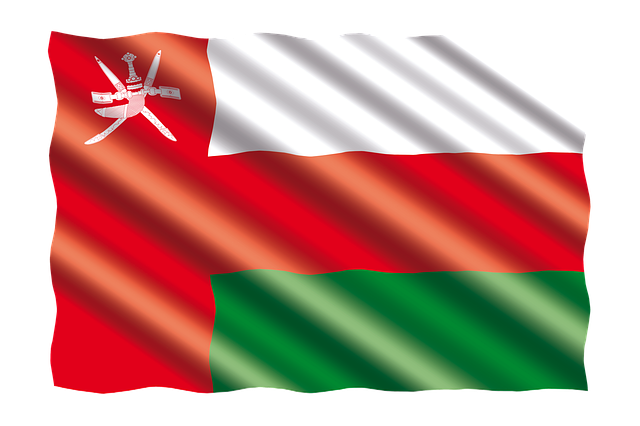
 The oldest independent state in the Arab world, is a 1700 km long coastal plain at the southeastern tip of the Arabian Peninsula lying bordering the Arabian Sea and the gulf of Oman. Barely inland from the coast, formidable mountains stand guard. A massive upheaval in the ocean floor hundreds of millions of years ago formed these mountains, producing modern Oman, one of the most colorful and geologically diverse countries on earth. The three bordering countries are Saudi Arabia, United Arab Emirates and Yemen. The official name of the country is Sultanate of Oman. A country that has , white sandy beaches, rocky mountain range, sandy desert area,wadis,palm-fringed oasis, and natural landscape. Trees and green grass lawns are a common feature, amazing for a country known as an oil rich desert. Arabic is the official language, English is widely spoken by the modern generation. Islam introduced in the 7th century is the state religion .It is now an ideal safe tourist destination, which has all the modern five star comforts for a stay, with unique historical sites and uncommon adventures to become a holiday to cherish with fond memories,
The oldest independent state in the Arab world, is a 1700 km long coastal plain at the southeastern tip of the Arabian Peninsula lying bordering the Arabian Sea and the gulf of Oman. Barely inland from the coast, formidable mountains stand guard. A massive upheaval in the ocean floor hundreds of millions of years ago formed these mountains, producing modern Oman, one of the most colorful and geologically diverse countries on earth. The three bordering countries are Saudi Arabia, United Arab Emirates and Yemen. The official name of the country is Sultanate of Oman. A country that has , white sandy beaches, rocky mountain range, sandy desert area,wadis,palm-fringed oasis, and natural landscape. Trees and green grass lawns are a common feature, amazing for a country known as an oil rich desert. Arabic is the official language, English is widely spoken by the modern generation. Islam introduced in the 7th century is the state religion .It is now an ideal safe tourist destination, which has all the modern five star comforts for a stay, with unique historical sites and uncommon adventures to become a holiday to cherish with fond memories,
During the olden days, Oman’s strategic location was used by Persians, Assyrians and Babylonians for trade with other parts of the world. Oman was never fully controlled by foreign powers, however partial occupation took place, and the main reason was its strategic position.Portugese dominated the region around Oman between 1507 and 1650, the Ottoman Empire between 1581 and 1888. In the mid 17th century the ruling Imam drove Portuguese out of the region.
Religion -Oman was one of the first countries to embrace Islam. Around the year 630CE, the Holy Prophet (P.B.U.H) sent a missionary, and the rulers of Oman embraced the new faith. Oman took up Ibadi Islam which was prior to the Sunni.Shia, split. Omani traders and sailors were important factors in spreading Islam around the Indian Ocean, Southeast Asia, and part of East Africa
Mosque –A place where Muslims worship. The word mosque comes from the Arabic word masjid.There are many mosques in Oman to facilitates worshipers throughout the nation.
The Sultan Qaboos Grand Mosque. This fine piece of architectural genius stands out from the rest in Oman. This is one of the only mosques that allow non-Muslim visitors. Beauty of this mosque is breathtaking and the ceilings are mesmerizing..Completion of the mosque was in the year 2001 after six years of hard work by a well qualified team of experts. It covers an area of 416000 square meters, and capable of holding 20000 worshipers. Building is made out of 300000 tons of sandstone. The mosque has the world’s largest single piece of carpet and chandelier. The chandelier is located in the center of the men’s prayer room hall and measures fourteen meters and weighs 8.5 tons. It holds 600000 shinning bright Swarovski crystals, 24 carat gold plating and took over 4 years to complete. One can imagine the tremendous efforts taken to create this master piece. There are over 20000 books in the library. It is beyond words to describe the beauty of this Majestic masterpiece, a creation beyond time.
Civilization -Archeological finds include flint tools, hearths and handmade pottery. Oman is considered as one of the oldest human inhabited places on earth, humans have lived for at least 106000years, and the city of Dereaze is about 9000 years old.
Oman had been inhabitant by many groups of people, and some came and left.Sumarians came over 4000 years ago and named the land as “Land of
Copper”. They were the first to export copper. Chaldea who came named the land as Iblita, Persians who came, were living for seven centuries. The Ad tribe who came based themselves in the desert. The Nabhani dynasty came to power and ruled Oman from 1154 to 1624, the Yoruba dynasty from 1624 to 1749, the Al Said dynasty from 1749 to date.
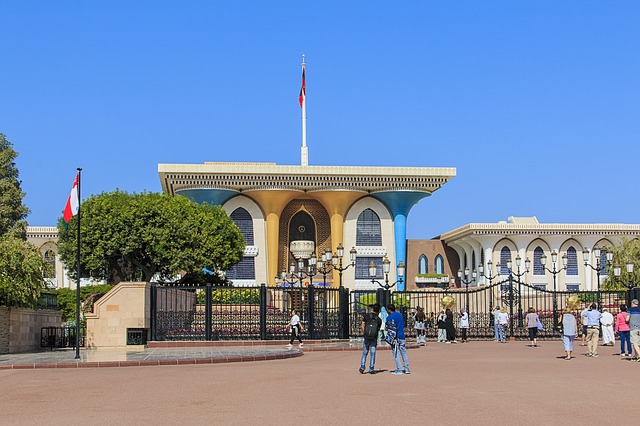
Modern Oman -His Majesty Sultan Qaboos bin Said Al Said ascended to the throne on the 23rd of July 1970, the modern Oman began from this date. Since this time the country has emerged as a prosperous and modern nation. Quality of life of the people, health and educational facilities has improved immensely.
Overall infrastructure of the nation has been improved to become one of the best states to be recognized worldwide.Cleaniness of the country is not second to any country in the world. Providing uninterrupted power supply and pipe borne supply of water to the residents was the first task. There are over 100 hotels;
some are built at very scenic places .Albustan Palace hotel and, Shangri-la Al Husn Resort and Spa are among the top ten.
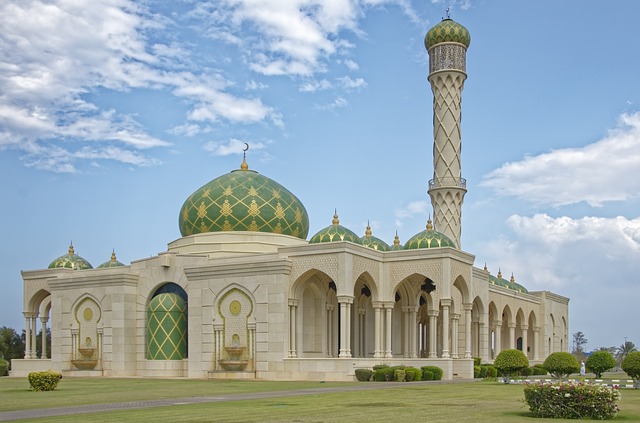
Administratively Oman is divided into 11 Governorates, and they are sub-divided into 61 provinces. Population in Oman is around 4.6 million (2017 census).
Climate- It is a known fact that desert countries have a warm climate. Summer temperatures can exceed over 50degree centigrade. Average temperature in the capital Muscat varies between 40 Celsius in June to 25 Celsius in January. Coast is about 20 celsius.Southern region of Dhofar has the mildest temperature. Average rainfall is 80-100mm.Northen Hajar mountains receive an average rainfall of 400mm.The best time to visit Oman is during the winter between November and March.
Oil producing Nation-Commercial oil was found in Yibal by Shell and Partex in the year 1962, thus an oil producing Nation was born. Soon several other oil wells were found, and the first export of oil took place in July 1967.Petroleum Development Oman (P.D.O) is the major oil exploration and product company in Oman.
Exports -Apart from oil, other major exports include organic chemicals, oil seeds wood pulp, fertilizers, fish, ships, boats, milling products, aluminum, and rawhides.
Industries in Oman –Oman has formed six industrial estates and free zones to promote industries to boom the economy of the nation and to provide employment to the locals
Industrial Estates –Rusayl, Salalah, Sohar, Sur, Nizwa, Burami.
Free Trade Zones – Al Mazunah, Salalah, Port of Sohar (special economic zone)
Animal husbandry-Cattle, goats, sheep, donkeys, camels are widely raised and poultry farming is gaining momentum to be self sufficient with eggs and chicken. Oman is one of the countries taking care of Arabian horses and devotes attention to its breeding.
Horses – The Arabian or the Arab horse is a breed that originated in the Arabian Peninsula Archaeological evidence suggests that it is one of the oldest breeds.
They are light and have speed and endurance hence a specific advantage during the days of warring .Omani saddle is known as Za,ana and is different to the saddles used worldwide. Distinguish feature is the absence of leg stirrups. Omani riders are considered among the best in the world. Horses in Oman are well trained and well disciplined, the training include walking, Khabeeb(faster than the walk slower than the sprint) and run. Royal Oman police and His Majesty’s Royal stables have the best breed of horses that are well trained. Race course in Oman is designed according to international standards. Horse racing is an annual even witnessed by many including dignitaries.
Camels –The camel nicknamed “ship of the desert” has a deep rooted relationship with the Omanis .Camel racing is a very popular sport in Oman. The Government gives special care to the camels through proper veterinary facilities.. Camels have the ability to withstand thirst and are capable of travel long distance, the ideal mode of transport during ancient times. Both young and old Omani’s appreciate the services of the camel, and takes good care of them.
Arabian Oryx Sanctuary-In late seventies H.M ordered the initiation of a project to save the Oryx from extinction and to settle them in their natural habitat in the desert and plains of governorate of Al Wusta of the Sultanate. Today there are over 600 Arabian Oryx in the sanctuary and visitors enjoy the site of the movement of these herds.
Agriculture in Oman has been ongoing for centuries, and the country has five agricultural regions, commencing from north to south. They include the Musandam peninsula, Al Batina coast, valleys and the high plateau of the Eastern Region, the interior oases and Dhofar region, along the narrow coastal strip from the border with Yeman to Ras Naws and the mountains to the north. Rainfall, falaj system and modern technology support are depending factors for agriculture.
Dhofar region grows Bananas, mangoes, coconut, lime, nuts and melon, wheat and rice. Winter crops are tomatoes, chilies, cabbage, okra, eggplant,
cucumber. Seeb and Barka are major farming areas that depend on drip irrigation system Organic and aquaponic farms are very popular basing on hydroponic technology fruits and vegetables are grown in the farms in Barka including grapes, carrot cabbage, corn and other verities.
An expert study carried out indicates that Dhofar region can be the hub to produce all the vegetables and fruits to the country. Thus Oman is on the way to ensure fruits and vegetables are grown locally to cater to the entire population.
Frankincense.-This is an aromic gum obtained from a tree and burnt as incense and used in perfume.. Dhofar region has over 8000 trees. Oman has revived an ancient perfume industry that flourished 3000 years ago and opened a new market for Amouge meaning waves in Arabic to Europe and USA.”
The Date palm – It resembles the Sultanate’s rich heritage. Old Omani’s cherished three things, date palm or the tree of life as some call it, to provide food, the camel for transport and the falaj for water to cultivate and quench the thirst.
These were basic survival mandatory requirements. The date palm trunk and the branches provided many things that were an integral part of the Omani home and household. Date farming is a major industry and processed dates are a major export. Date honey is a byproduct .There is about 250 varieties of dates, and there are over eight million date trees in Oman.
Fishing; Oman has about 1700kilometers of coastline, and its history as a seafaring nation dates back a few centuries .Fish is a staple diet of the Omanis. Small fishing boats can be seen on the beaches from Sohar to Salalah.Fishermen venture into sea early hours of the morning, and return with nets full with loads of fish. Fishing is part of the livelihood of many, who inherited it from their fore fathers.
Voyages -Oman was known as the land of explorers as the expertise of these dhow sailing Omanis’ were highly sought after by explorers from distant lands and, during the period when there were no large cargo liners or commercial jets to make the world accessible by the sky. Omani sailors were brave in facing rough
seas and other terrors during journeys in the ocean. They had an excellent knowledge of seasonal weather patterns, astronomy and art of navigation. It is believed that Omanis pioneered the use of the mast and sail.Al-Masudi the Great, the tenth century Arab traveler who made the 8000 miles long voyage in the ocean between Abyssinia, India and China, and that most of the marines were Omanis.
Trading routes-To trade Frankincense from Dhofar, Omanis followed the trading routes through sea to Egypt, India, Rome and China.
Ship Building-Omanis are one of the greatest ship builders in the world. In Oman the traditional fishing boats are still produced from memory, without plans and drawings, and the entire process takes three to six months. Building of a dhow takes also takes about 3 to six months depending on the size of the ship. The town Sur is famous for ship building; the required wood (teak) is brought from India. The ships sambuk and ghanjah were built in Sur which went as far as India, Zansibar, Iraq, and China. These vessels were also used for pearl fishing.Sur has retained its reputation as a ship building town.Hamood al Ghilani is considered as one of the main world leading ship builders in Oman
Pottery- The art of pottery making has been existing in Oman for over 4000 years. Presently pottery items are mainly used as decorative pieces in homes, shopping malls and gardens. These items are popular souvenirs. The art of vessel making is an industry in Oman.Bahla is famous for pottery making, the reasons behind are that the soil of the nearby wadi is rich in red clay used for making clay utensils and the artists have magical fingers which allow them to master the ancient art and create very fine and strong items.
Omani mandoo-The wood in Oman is valued for its high quality and it is flexible to be shaped and engraved into different tools and objects. Decorative doors and windows are made out of the wood but the most famous item is the mandoo, a wooden chest made in various sizes and decorated. It can be used to stow clothes, jewelry or other items.
The Khanjar and Omani Silver-This Omani dagger known as the khanjar represents the unique Omani culture. It is also featured in the National flag. Men wear it in a belt around their waist for important occasions and national festivals, weddings and other social events. It is made out of Omani silver, and the handle is
made out of ivory. Omani silver is of very high quality and famous among the Arab world.
In the past Omani women’s jewelry was made out of Omani silver, and wide verities are still produced. Some items are necklaces, rings, earrings, bracelets, anklets and other items which are very precious gifts.
Souq– A souk is an open market place, and there are several of them in Oman.
Muttarh souq– This ancient souq near the Cornish beach and the old town is visited by many people, as it retains the traditional Arab market atmosphere. Although housed under modern timber roofing with old buildings on either side of the gully which serves as the market. Shops sell Omani artifacts, fruits vegetables, traditional silver ornamental items, groceries, dates, bee honey and many other items, including jewelry and hardware. Few coffee shops cater to the coffee drinkers and small restaurants serve short eats and soft drinks.
UNESCO world heritage sites in Oman –following five are listed by UNESCO as world heritage sites.-Falaj irrigation system, Ancient city of Qalhat, Archaeological sites of Bat, Al-khutm, and Al–ort, Bahia Fort, Land of Frankincense.
Falaj irrigation system-These are ancient water channels dating from 500AD located in the regions of Dakhiliyah,Sharqiyah and Batina.Falaj does systematically divide the water among all the inhabitants and to the lands for agriculture.
Watchtowers are placed to protect the system, as water is so precious in a desert. The system depends on water underground and is extracted by a simple method without using any machines. It is amazing to see how water is transported through the canals for long distances in mountain areas. A technically correct system is in place to control and divide the water as required.
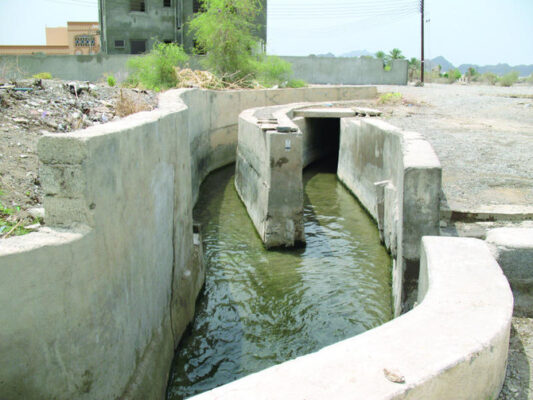
Image Source: Arab News
Ancient city of Qalhat- This ancient city dates back to pre-Islamic times. Once it was a key hub for trading. In the 13th century, Governor Ayaz was ruling both Hormuz and Qalhat.During his absence Qalhat was ruled by his wife Maryam, and she continued ruling the city after her husband’s death. She built the Great Friday mosque and a mausoleum. Marco polo visited the city in the 13th century and Iban Battuta in the 14th century. Iban Battuta wrote that the city has good markets and one of the most beautiful mosques in the world (he mistook the structure for a mosque).Both Marco Polo and Battuta praised the city for its beauty. The ruined city has the Bibi Maryam Mausoleum, but it has lost its dome.
Archaeological sites of Bat, Al-khutm, and Al-Ayn.
The ancient archaeological complex of above areas are one of the most complete and well preserved settlements and necropolises, from 3rd millennium
BCEworldwide.Core site is part of the village of Bat, about 24kilometres from the city of Ibri.Seven monumental stone towers have been discovered at Bat. The outer walls of the towers are circular and measures around 20-25m in diameter. Further extensions to the site of Bat are represented by the monumental tower at Al-Khutm and by the necropolis at Al-Ayn.
Bahla Fort Banu Nebban tribe built this fort between the 12th and 15th century, a part of the complex has a citadel oasis adjacent to the fort and an ancient wall, thirteen kilometers long. It is located at the base of the Jebel Akdhar mountain. It is an outstanding example of Islamic medieval era oasis settlement. After extensive restoration the fort is now opened to the public.
Land of Frankincense This is a site in Oman on the incense road, and it includes frankincense trees, Port Khor Rori and the remains of a caravan oasis, which were of prime importance to the medieval incense trade. There was a time when this commodity was more precious than gold. The trade thrived throughout the Arab peninsula, North Africa, the Mediterranean, India and China. Travelling group of traders would walk throughout these areas and settle in makeshift camps close to their most voluble products, which are prized for their aromic resin often used in perfumes and religious rituals.
Wadi
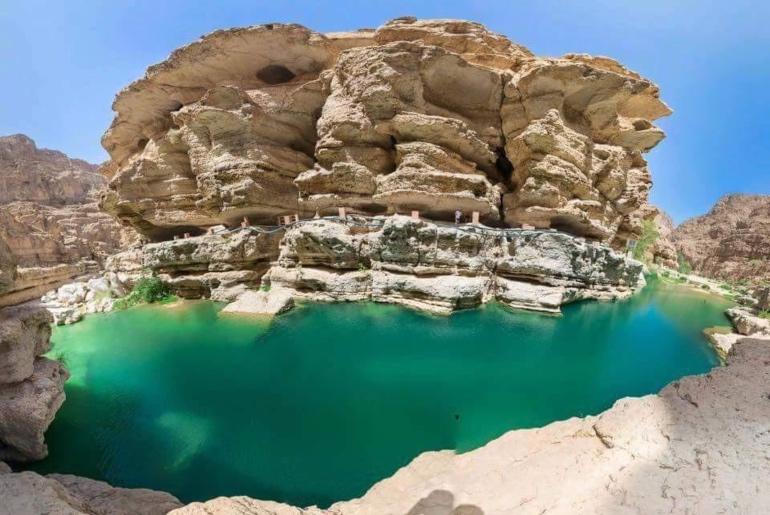
The bed or valley of a stream, which is usually dry, except during rainy seasons, and that often forms an oasis. The wadis of Oman are a major attraction, unique in many ways and people have lived in wadis of Oman for thousands of years. Flowing through heavy rock formations, palm trees grow in these beds
surrounded by fertile environment. Certain Oasis retains water throughout the year.
There are many wadis in Oman and five of the best are given below.
Wadi Shab, Wadi Bani Khalid, Wadi Al Arbeieen, Wadi Al Hawqayn, Wadi Damm.
Wadi Al Hawqayn-The drive is about two hours from Muscat. It is one of the most beautiful wadis which retain water throughout the year It has flowing streams, waterfalls, and both sides of the wad is filled with lush greenery. It an amazing site which mother nature has gifted to Oman.
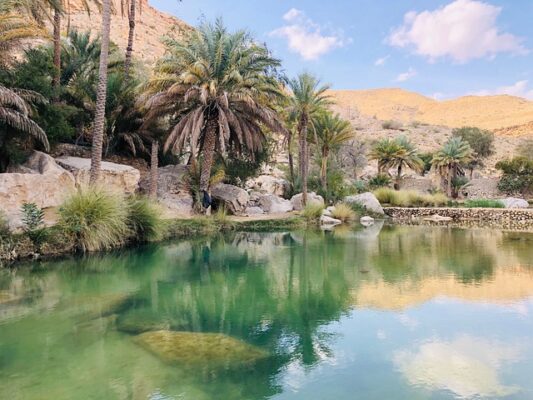
Forts in Oman
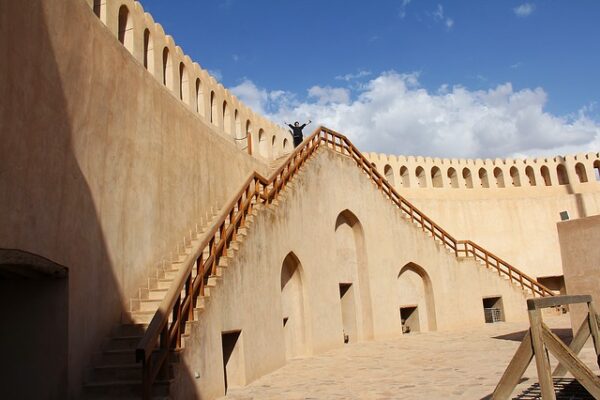
Al Jalali fort, Al MIrani fort, Bahla fort, Al Fiqayn fort, Muttrah fort, Nakhal fort, Al Rustaq fort and Nizwa fort.Few existing forts in Oman indicate the ability of ancient Omanis to design and build such towering structures thousands of years back, and is evidence of the rich Arabic culture, engineering marvels with fine architectural skills.
Nizwa Fort
This was built in the year 1650 by Imam Sultan bin Saif Al Yarubi.12 long years were taken to complete the bulk of the fort, which was built above an
underground stream. Main part of the drum like tower is 30 meters in height and with a diameter of 30 meters. The strong foundation goes 30 meters into the ground. There are 24 openings on top of the tower for mortar fire Entrance of the fort is guarded by two cannons. Those who mange to enter ,risked being burnt by boiling oil or water, poured through shafts which opened directly above each set of doors known as murder holes. Underground cellars stowed plenty of food to last during a battle, and the stream provided permanent supply of water.120 guards kept watch along the wall all around the tower. Further 480 gun ports allowed for a concentrated barrage of fire during an attack. The interior was well planned with high ceiling halls, rooms, doorways, terraces, stairways and corridors. The design of the tower with secret shafts, false doors and wells, indicates deserved architectural deception
Castles in Oman. The existing castles show the rich Arabian culture and the ability of some fine architects. and it also proves that they were not just nomadic herders. Those structures are a challenge and an education even to the present generation.
Al Ainayn, Al Hazm, Al-Hillah,Al-Mintarib,As Sulayf,As Sunaysilah,Bayt Ar Rudaydah,Bi lad Sur, Al Khandaq,Ibri,Jabreen,Khasab, Ras Al-Had are few of the prominent castles.
Jabreen Castle– This was built in the year 1670, the designing and supervision was overseen by Al Imam Bel Arab bin Sultan Al Yarubi. The castle is rectangular in shape with five floors and 55 rooms. The ceilings are decorated with paintings and Islamic- era inscriptions. It has beautifully carved doors and the castle has two sections, one rises to 16 meters with two storeys and the second rises to 22 meters with three storeys. A falaj runs through the middle of the castle. The Sun and the moon rooms are very significant. It features 14 windows and a ceiling that has an eye shaped designs. The inner central yard provides a private airy outlet to step in to the dining area. Imam protection room has a floor underneath for the guards to hide when required to protect the Imam, during meetings with untrustworthy people. There are four secret hideouts under the room which are interconnected.
Royal Palaces
there are six royal residences of the ruling monarch. Al Alam in Muscat and Royal Salalah palace in Salalah, are two among them.
Al Alam Palace – The Arabic meaning of Al Alam is The Flag, The palace was built by Imam Sultan bin Ahmed, and it has a history of about 200 years. The existing palace in Muscat has a façade gold and blue. It was rebuilt in the year 1972 as a Royal residence. Inner grounds of the palace are off limits, but visitors are allowed to wait near the gate and take photographs. The palace resembles Islamic architecture.
Sports – In the olden days the most popular sports were ,Horse racing, camel racing,Falconary ,Dhow racing ,Bull butting( in some areas like Al Batina).These are popular even today. However adapting to most prominent sports in the world today, football is now played in Oman which is the number one popular sport among the locals. Other sports activities are, cricket, hockey, volleyball, beach volleyball, basket ball, net ball, boxing, tennis, swimming, handball, sand boarding and golf.
Golfing in Oman- Oman is gaining momentum as an ideal golfing destination. Sunny weather combined with mild temperature (seasonal) , great hospitality, with surrounding rustic deserts, palm trees, sparkling blue waters, makes the round of golf a memorable experience. Oman golf courses were designed by experts in the game.Almouj golf course was designed by Major champion Greg Norman and matches his standard and style.
Leisure activities in Oman
Oman’s diversified environment makes it a very popular tourist destination. It has plenty of attraction for the tourist and is well known for culture tourism. Muscat was voted as the second best city to visit in the year 2012 by the travel guide publisher Lonely Planet, and in the same year Muscat was chosen as the capital of Arab tourism.
Oman has the highest mountain range in the peninsula, from the desert area to the lush green south with its fruit plantations and wildlife such as Oryx and
gazelle. The blue water sea with white sandy beaches is a true paradise for the nature lovers. Mountain scenery features, pomegranate fields ,rose gardens,
vegetable garden patches, date palm cultivation ,scenic villages,mesmarising landforms such as Bimmah sinkholes,wadis ,marvels of the falaj irrigation system, ancient architectural superiority in constructing forts and castles, unspoilt coastline brim with marine life in coral reef ,spinner dolphins, humpback and blue whales, incredible variety of flora ,fauna and birds are a heaven for eco tourist. Out of the many interesting places to visit few are given below.
Wahiba Sands
South of Muscat has a desert area named Wahiba sands which is a 3 hour drive from the capital. They are longitudinal dunes 200 kms long and 100kms wide running south from eastern hajars to the Arabian Sea. It has an area of 12500 square kilometers. From Muscat one has to proceed to the small town Ibra which is passing Sur and follow directions from there to Wahiba Sands. Sign posts are located every 1km to facilitate a traveler. Heading to Wahiba sands in a 4WD is a true desert experience to remember .Colour of the sand is a shade of brown but it changes to gold or reddish depending on the temperature. The sand dunes are high and only an experienced drive that is also a good guide could drive around to experience the rolling dunes .There are no permanent settlements in Wahiba sands but there are temporary settlements of the Bedouin tribe, and you get a chance to meet them. Plenty of camels wonder around. Spending a night in a rustic goat –hair Bedouin tent, having dates and coffee by the fire and gazing at the sky is a unique peaceful experience.World,s highest sand dunes are located here and the experience to go up and come down from a hill is a challenge even to the experienced driver. It is a life experience to the tourist. This is the desert that you always wanted to see.
Ras Al Hadd
Ras Al Hadd is located at a distance of 30 minutes drive from the town Sur. The place is supervised by local authorities and visitors are allowed by registering at the point of control. Turtles do come here all year around to lay eggs in the night and leave just prior to the rising of the sun. Early morning baby turtles struggle to get to the sea.
Drive along the coastal road to Quriyat along the rugged coast with mountains on one side and the ocean on the other side. It gives an opportunity to see the village of Wadi Shaab it is an oasis full of palms and banana trees. Walking though the wadi, will lead to the pool area to swim and witness the water falls. A short stop at Sur will allow seeing the Dhow yards. After watching the turtles and spending the night in a hotel return back to Muscat via Wadi Bani Khalid to have a swim, visit a Bedouin family for a treat with dates and coffee. Jebel Akhdar meaning the green mountain is part of the Al Hajar mountains range
in Ad Dakhiliyah Governorate in Oman. The drive is about 45 minutes (olden days it took 6 hours) from Nisswa. The place is known for its rose water extraction and agriculture products that includes, pomegranates, walnut, apricot, black grapes, peaches. Temperature between Dec and March is 5 degree C and the annual rainfall is between 250-400mm. There are hotels on the top for an overnight stay to watch the sunset and sunrise. It has more greenery to admire and few ancient ruins .There are few villages where some tribes still make it home, in this very pleasant climate. Part of the Jebel Akhdar range is Jebel Shams (mountain of the sun) which is the highest point in Oman. Using a four wheel vehicle it is possible to drive up to Jebel Shams which is located in the north of Al Hamra town, and is about 240kms from Muscat. Temperatures in the summer are 20degree C and in the winter it drops below zero degree C. Wadi Nakhr can be viewed from the top of Jebel Shams which is the grand canyon of Oman’.
Beaches Oman is famous for its safe and clean beaches, few names are AL Mughsay in Dhofar,Bandar Jissah,Al Sawadi ,Duqum,Masira Island,Al Bustan , Ras Al Hadd,Tiwi,Musandam,Khasab,Masira, Qurum are a few of them.
Qurum Beach is just 20 minutes away from the city. Many hotels are built around this area. The beach stretches for 4 kms. The golden expanse of the sand is
encouraging to lie down to relax, it is safe to swim in this turquoise coloured water. Many take to the sea to sail, and is an Ideal place to play beach volleyball
or football. Beautiful Quorum Park is a few meters away, with verities of roses and other flowers. A boat trip to Masirah Island and Khasab are two places that is enjoyable There are many good cruises to enjoy such as Dolphin watching and snorkeling cruise ,sunset dhow cruise. Certain sea areas have beautiful rock structures as if they are carved in the middle. The main tourist attraction between Barka and Sohar is the Sawadi and Daymaniyat islands, and is also one of the islands leading diving spots and often explored for swimming and snokeling.Rockey and windswept Sawadi Island lies just offshore. The beach has a lot to offer for the seashell collectors. Boat trips to Sawadi and Damniyat islands are favorite past times among both locals and tourists.
Camping in Oman
Camping in Oman is allowed and it is one of the best ways to enjoy nature, it can be on the beach, desert, and mountains or near wadis.There are many places in Oman and one place that stands out is Wadi Shab.
Wadi Shab Drive to the place takes about 1 hour and 40 minutes from Muscat. It is located in a place called Tiwi, a part of Sur.Areas of this wadi are only accessible by boat..To reach to the waterfall cave one has to hike 3km,a fully worth experience. From the parking area villages can be seen where a boat can be hired to go across the pond. By walking along palm groves on rugged rocky cliffs, and swimming through some pools can reach the main goal, the submerged cave with waterfalls, this hard to get experience is worth and safe to camp and enjoy the sound of birds in the morning at sunrise.
Some interesting visits
Al Hoota Caves 5 kms long natural cave in Al Hamra discovered by locals some hundred years back was opened to the public in December 2006.It is now a major tourist attraction. The cave has two underground lakes.
Bimmah sink hole, Wadi Dayquh dam (modern Oman project), Royal Opera house (modern Oman project), Wadi Gul Oman Grand Canyon are few interesting places to visit.
Salalah – It is the capital city of the Dhofar province also the birth place of H.M, Sultan Qaboos bin Said, who is the present ruler of Oman. It is known for its plantations; The Khareef an annual season between the end of July to beginning of September transforms the desert terrain into lush green landscape and creates seasonal waterfalls. Extra flights and other modes of transportations are arranged to cater to thousands who travel to Salalah during this period.
Scenic Drives in Salalah- Driving to the wadi Sahalnoot gives an opportunity witness natural scenary. The roads have steep bends and trees on both sides to
make the drive interesting. Driving to the top of Ittin Mountain gives a great view of the Salalah city. The Ayn Jarzis spring is nearby.
Some Interesting places to visit in Salalah
Water Falls during Khareef season
Paddling at wadi Darbat (during Khareef season)
Experiencing the sunset from the cliff of Taqa
Stall on the Mirabat beach
Soak with water splashes at Al Mughayl blow holes
Drive to the anti gravity point
Visit the archeological sites at Al Baleed and Sumhuran.
Visit Taqa castle in Taqa and Mirabat fort in Mirabat
Hunt for souvenirs at the Haffa souk
During the stay in Oman one would have consumed may cups of coffee or kahwa as locals call it with dates and some delicious Halwa which is one of their
favorite sweets served during all cerebrations and functions and festivals.
Try the famous traditional Omani recipe of Halwa
tapioca starch: 2 cups
Water: 1 ½ cups
Sugar: 4 cups
Water: 4 cups
Red food coloring: ½ tsp
Saffron strands: few
Ghee: ½ cup
Rose essence: 1 tsp/ Rosewater: 2 tbsp
Cardamom powder: ½ tsp
Nutmeg powder: ½ tsp
Toasted sesame seeds: 1 tbsp
Cashew nuts: 20
Pista flakes: 20
Almonds
Oman is a country blessed with unparalled natural beauty. The people of Oman live gracious gentle lives. Oman is a model of third world development that
respects its past, yet lives harmoniously with forces that propel it on to the 21st century.
Under the leadership of the wise leader, His Majesty Sultan Qaboos Bin Said Oman is a peaceful and progressive country; he has a genuine interest and
concern for the wellbeing of his citizens. His Majesty is widely respected as one of the great leaders of his time and has been internationally lauded and recognized for his work towards peace in the Middle East. The international peace award was presented to his Majesty in 1998 by former US President Jimmy Carter who mentioned his admiration for the Sultans courageous efforts to mediate for countries within the region in times of conflict, for settling difficult boundary disputes with all of his neighboring countries and his encouragement of the Camp David peace accord. Jimmy Carter said “His Majesty has set an example of leadership and I pray will be followed by others throughout the world”







